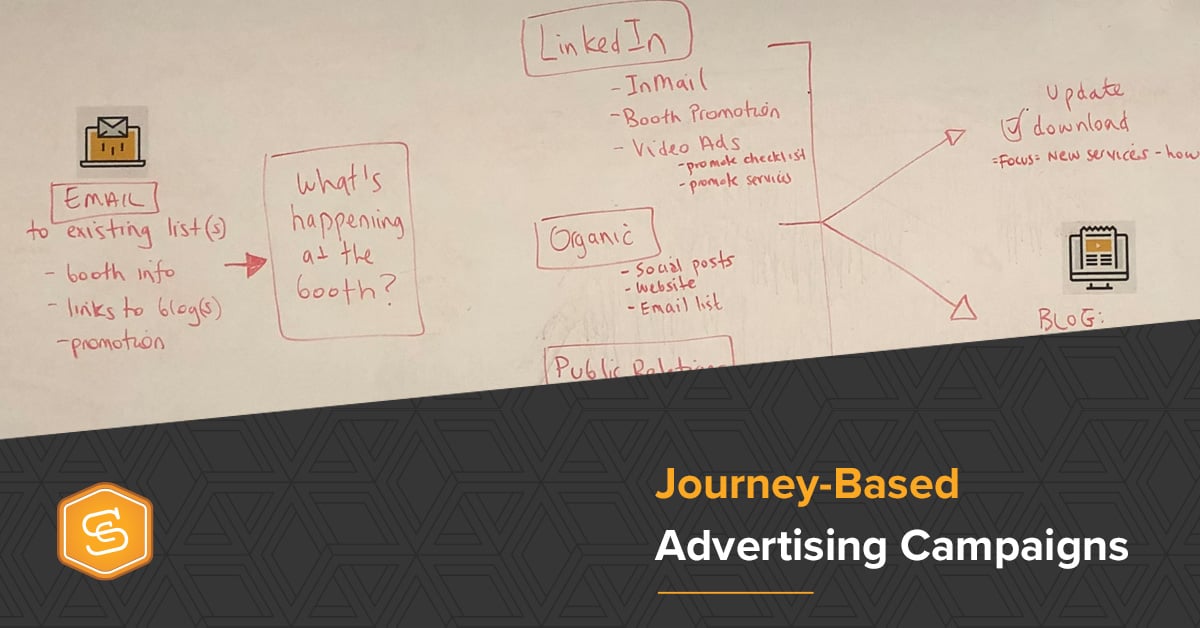
The world of advertising has changed a lot over the years. Early advertisers could choose publications or television shows that their target audiences may enjoy, but that's about as far as targeting went. The rise of digital ads and big data, fueled by the massive growth of companies like Google, Amazon, and Facebook, now allows advertisers to make hyper-specific targeting decisions about exactly who they want to reach. It's now cheaper than ever to get your ad in front of the exact type of person you'd like as a customer. The problem is, ads are everywhere. They are background noise at best and annoyances at worst. In order to cut through the clutter, you must do things differently. You must stop viewing advertising as a way to bring in money and start viewing it as a way to build relationships. Because, ultimately, relationships are how you make money. One of the best ways to do this is through journey-based advertising.
Overview of Journey-Based Advertising
While ads are increasingly being ignored, organic traffic is down as well. The major platforms are picky about what they show to their customers, so your reach doesn't reach quite as far as it once did. You need to augment your organic traffic with ads, and you need to do it in a way that will cause the potential customer to engage rather than disengage. So, what is journey-based advertising, and how does it help you engage with your customers more effectively?
Journey-based advertising accomplishes that by tailoring your ads to where the customer is at in their journey. If they don't know what your product is yet, offering them a demo doesn't make much sense. Instead, show them an ad pointing to content that can help them understand how to solve their issue (using your product), and they'll be more likely to click. Continue tailoring those ads throughout the journey and you'll build a relationship with the customer. Once they know what your product is and how it can help, they'll develop some loyalty to your brand before you even show them the ad for the demo. You'll be with the customer every step of the way rather than attempting to rush them through the checkout line. This will keep them engaged and set you apart from other advertisers.
Benefits of Journey-Based Advertising Campaigns
Journey-based advertising has multiple benefits. Some of the benefits come directly from the strategy itself. Others come from the fact that you must understand your customers better in order to make the most of a journey-based advertising methodology. This means that you'll be able to craft better buyer personas and reap the benefits that those bring as well. Let's look at some of the ways your business will benefit when you adopt journey-based advertising.
Aid Your Customers Rather Than Annoy Them
Consumers are swamped with advertising these days. Many have learned to just tune them out. Others are actively annoyed by them. Journey-based retargeting engages with the customer in a meaningful way, so they find the ads helpful rather than annoying.
Build Strong Connections With Your Customers
As your potential customer's journey progresses, your ads will continue to be a resource to them. They'll begin to see you as an answer to some of the pain points they are having. This stronger connection will keep you in the forefront of their mind the next time they need the type of products or services you offer, resulting in stronger loyalty to your brand.
Better Empathize With Customers
As you begin to understand your customer's journey, you'll also begin to understand the problems that they face. You'll be able to address their pain points by virtue of the fact that you are retargeting the right information to them at the right time, but you'll also understand those pain points better and be able to adapt your strategy to serve your customers better.
Improve Your Ad Targeting
As you learn more about the journey your customers take, you'll learn more about who they are. Understanding your target audience better will play a huge role in your ability to target your ads effectively. This boost in ad efficiency augments the boost you'll already be seeing from the journey-based campaigns themselves.
Use Your Buyer Personas to Create / Write Converting Ad Copy
As we mentioned earlier, understanding your target audience means being able to craft better buyer personas. Buyer personas tell you the type of language and tone you should use when writing copy, not just for ads, but for every aspect of your business —writing in a way that customers relate best to will increase conversions.
How to Get Started Using HubSpot Ad Sequences
Now it's time to learn how to create a journey-based retargeting campaign. HubSpot's automation tools make it easy to create a campaign as a sequence of ads that will play out in a logical order. The HubSpot website has detailed information on how to use these tools to create an ad campaign using Facebook ads. We'll give you a brief, platform-agnostic version of how to use HubSpot ad sequences here.
Attract
We already gave an example of the Attract step a little earlier. This is your first contact with a potential customer. They don't know your brand or what you can do for them, so you don't want to go right in on trying to sell them something. Instead, target people you think your product or service will help and place an ad linking people to a helpful blog, video, or social media post. The purpose of this ad is simply to introduce your company to the prospect, begin building brand awareness, and most importantly, establish yourself as a trustworthy expert in your field.
Gently guiding customers through a funnel in this way is nothing new to you if you are familiar with inbound marketing. Journey-based advertising is really just taking those inbound marketing concepts and applying them to your advertising campaigns. The next step in your customer's journey is clicking on the ad and consuming the content. When they've done that, they are ready for the next ad in the sequence.
Convert
Here is where the power of HubSpot ad sequences and journey-based advertising come into play. In the Attract step, you cast a relatively wide net with your targeting. The goal was to attract anyone who might be interested in your products and services. Once they've seen whatever content you've initially shown them, they don't need to see it again. They are past that step in their journey. So, the second ad should only be for people who have clicked on that first ad and engaged with your content.
If you're familiar with inbound marketing, you may realize how this next ad fits into the puzzle. Although it may be tempting, it's still not time to try to sell your product or service to your prospect yet. Instead, we want to bring them deeper into the funnel and turn them into a full-fledged lead. To do this, advertise something that will get them to give you their contact information. Just like on your website, this could be an eBook, an exclusive video, or anything else that will have enough value for them to exchange for their email address.
Close
With the potential customer further into the funnel, you want to retarget them one more time. As you may have guessed, this third ad only goes out to those who have filled out the form from the previous step. They are on the final leg of the ad journey and will be shown an advert to match. For this ad, you'll send them to one of your landing pages. Keep in mind that the final leg of the ad journey is not the same as the final leg of the buyer journey. The page you send them to still must do its job and push them into the final step of making a purchase.
You'll notice that there was no hard sell at any point in this journey-based ad example. You guided the prospect through their journey by showing them things they may be genuinely interested in. This is why journey-based advertising is so effective. It can take the annoyance factor out of ads and still get people right up to that final step of being ready to make a purchase.
Bottom Line
HubSpot's ad sequences make it easy to follow your prospect as they go through their journey and show them the right ads at the right time. The data you collect from who makes it through the funnel and who doesn't will give you useful information about your customers that you can use to craft more effective buyer personas. However, HubSpot's utility goes far beyond ad automation. For a look at what some of the versions offer, you can check out our previous posts comparing HubSpot's Sales Professional vs. Sales Enterprise packages and Sales Starter vs. Sales Professional packages. If you'd like to learn more about how HubSpot can help your business, please feel free to contact us. We'd be glad to answer any questions you may have.




